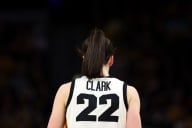You have /5 articles left.
Sign up for a free account or log in.

Athlete Maddie Salamone speaks to the NCAA steering committee about lack of athlete representation in the Division I proposal.
NCAA
SAN DIEGO -- A day after faculty members and athletics directors expressed concern that athletes are being left behind under the proposed new model for Division I, a national Student Athlete Advisory Committee chair issued a strong statement backing that view here at the annual National Collegiate Athletic Association convention.
"There's been a lot of rhetoric around this room about how important the student-athlete voice is," Maddie Salamone told the 800 college presidents, athletics directors, faculty athletics representatives, conference commissioners and NCAA staff gathered for day two of a "dialogue" about the proposed model. "The proof is in the pudding.... The student-athlete voice is not as meaningful as we have been led to believe in the past."
This discussion comes at a time when the NCAA is under attack on multiple fronts with regard to how it treats athletes. Lawsuits over negligence in managing head trauma and the rights of athletes to profit off others' use of their image are, if not coming out of the woodwork, becoming fairly common. While officials at many big-time programs say they are acting in athletes' interests and want to do even more -- specifically, provide financial aid up to the full cost of attendance -- including the players in decision-making in areas such as safety, recruiting and amateurism rules could certainly steer those discussions in a different direction.
The debate over Division I restructuring is the result of strong-arming by the biggest and wealthiest conferences in the Bowl Championship Series: the Atlantic Coast, Big Ten, Big 12, Pacific-12 and Southeastern Conferences. Their member institutions want more power -- or, as it's called in the proposal, "legislative autonomy" -- to set their own rules regarding academics, recruiting, financial aid and athlete benefits. While the biggest programs have athletic budgets up to 20 times those of the smallest Division I programs, all institutions currently play by the same rules.
There was plenty of rhetoric about the new model being designed to better serve athletes and maintain the core NCAA mission of athlete success and well-being during the two-day summit. But nowhere in the 14-page document describing the several-committee structure, guiding legislative principles and core values of the new model are athletes guaranteed representation in the governing process. That is despite the fact that the model is designed to give more say and legislative power to boots-on-the-ground "practitioners" such as athletics directors who, unlike college presidents, deal with the minutiae of athletics on a day-to-day basis.
Division I members were quick to point out this apparent contradiction Thursday, as well as the fact that athletes appeared to be secondary in some ways. (For example, "student-athlete well-being" is listed as a governing principle, but not as an NCAA core value.)
Asked how athletes fit into the new model, Wake Forest University President Nathan Hatch, who chairs the Division I Board of Directors, said awkwardly, "I'm not sure we've wrestled with that substantially."
On Friday, Salamone kicked off the "dialogue" -- which was really a lot of people talking at the six presidents representing the steering committee that created the proposal, and them not doing much responding -- by asserting that she and her peers were an "afterthought" in the new Division I.
"We are the only ones affected by these rules 24 hours a day, 365 days a year," she said. "Anybody that is going to create and pass legislation relating to student-athletes must have an athlete on that board, with voting and advisory [influence] at every level."
Presidents insisted throughout the convention that it's important to "have athletes in the room" when rules are made, but stopped short of promising voting power or even seats on the Council, the body that will create legislation, or the Board of Directors, the 17-member body of college presidents that will approve new rules.
But the presidents also noted repeatedly that the proposal is not "a baked model," and that the point of the dialogue was to gather membership input to make changes that were necessary.
After the two-day, six-hour marathon session, which only half of attendees said was actually useful in a poll Friday, Inside Higher Ed spoke with Rita Cheng, a steering committee and board member who is chancellor of Southern Illinois University at Carbondale. Asked whether she thought Salamone's assertion that the athlete voice isn't valued was "unfair," Cheng said she thought it was.
"I think that the straw man wasn't complete," she said of Salamone's comment. "Student-athletes are the reason we are engaging in the dialogue."
But Cheng acknowledged that the steering committee may need to do a better job articulating exactly how athletes fit into the new Division I governance.
"We need to be very clear about our commitment to student-athletes, and if we weren't, we'll get it done right," she said. "Our intent ... was to bring everyone involved into the decision-making process."
The steering committee is aiming to nail out the details of the plan by the April Board of Directors meeting, and put a final proposal up for a vote by August. Cheng said athletes may get voting rights on the board or the legislative council, or both.
"Most of our boards in colleges and universities include students, and the reason is to get perspective," she said. "It is always important to have students in the room."
The committee gathered feedback via individual and group comments Friday, but also through a series of polling questions. One-third of the audience members were athletics directors, 14 percent each were faculty athletics representatives or senior woman administrators, 9 percent each were college presidents or Division I staff, and 20 percent were "other," including athletes and conference commissioners. Forty-three percent were from Football Bowl Series institutions, and 30 percent were from the smaller Football Championship Series programs.
Sixty-seven percent of attendees said athletes should have voting representation, while 80 percent think athletics directors should have voting rights.
Some of the other polling results are listed below.
| Fundamental principle of presidential and chancellor control of athletics: | |
| --Strongly support | 38% |
| --Support | 37% |
| --Neutral | 8% |
| --Oppose | 13% |
| --Strongly oppose | 4% |
| Legislative autonomy for the "Big 5" conferences: | |
| --Strongly support | 27% |
| --Support | 31% |
| --Neutral | 12% |
| --Oppose | 17% |
| --Strongly oppose | 13% |
| In shared NCAA governance, equal representation in voting for all conferences (as opposed to the current system of weighted voting power by conference): | |
| --Strongly support | 38% |
| --Support | 37% |
| --Neutral | 8% |
| --Oppose | 13% |
| --Strongly oppose | 4% |
| It is crucial to maintain the legislative override system, in which 62 percent of colleges' opposition to a rule halts the legislation from taking effect: | |
| --Strongly support | 36% |
| --Support | 37% |
| --Neutral | 12% |
| --Oppose | 10% |
| --Strongly oppose | 5% |
| This model will enhance public perception and reduce external risks such as lawsuits: | |
| --Strongly support | 2% |
| --Support | 12% |
| --Neutral | 39% |
| --Oppose | 29% |
| --Strongly oppose | 18% |
| NCAA enforcement should be outsourced: | |
| --Strongly support | 16% |
| --Support | 29% |
| --Neutral | 20% |
| --Oppose | 22% |
| --Strongly oppose | 13% |
| This is a useful dialogue: | |
| --Strongly support | 16% |
| --Support | 34% |
| --Neutral | 27% |
| --Oppose | 15% |
| --Strongly oppose | 9% |








